 USA (1888-90): Protected Cruiser C-5 1890-1937
USA (1888-90): Protected Cruiser C-5 1890-1937WW1 and prewar USN Cruisers
Atlanta class | USS Chicago | USS Newark | USS Charleston | USS Baltimore | USS Olympia | USS Philadelphia | USS San Francisco | Cincinatti class | Montgomery class | Columbia class | New Orleans class | Denver class | Chester class | Omaha classUSS New York | USS Brooklyn | Pennsylvania class | Saint Louis class | Tennessee class
USS San Francisco (C-5) was a steel armour protected cruiser built in 1888-90 for the United States Navy. In her career she freed her named early, becoming Tahoe and then Yosemite until decommissioned a last time in 1921. She was a successor to Newark as a commerce raiding masted cruiser, but more modern and with a main armament of twelve 6-inch guns. Built at Union Iron Works in her namesake city of California she was commanded by no other than Captain William T. Sampson, future admiral and winner of the Battle of Santiago. At this time in 1898, she was deployed along the Florida coast and off Cuba but did not take part in any combat deployment. In WWI she became a minelayer, laying a total of 9,102 mines, officially becoming CM-2 postwar (specialized cruiser minelayer), long into reserve and changing names until stricken in 1937 and scrapped in 1939.
Development
USS San Francisco at its core was a repeat, improved, of USS Newark. The latter was a classic long range commerce raider typical of the early years of the “new navy”, ideal for distant stations and still capable to take part in limited battle line actions. For memory her precedessor USS Newark (C-1) was designed back in 1885 by the Navy’s Bureau of Construction and Repair and Bureau of Steam Engineering, based on specifications from a special advisory board under Secretary of the Navy William C. Whitney. The first design was thought inadequate and it was believed not possible to mount 8-inches guns on such cruisers, only 6-inches guns. She was to have also a complete armored deck in the European fashion, gun shields and a conning tower.
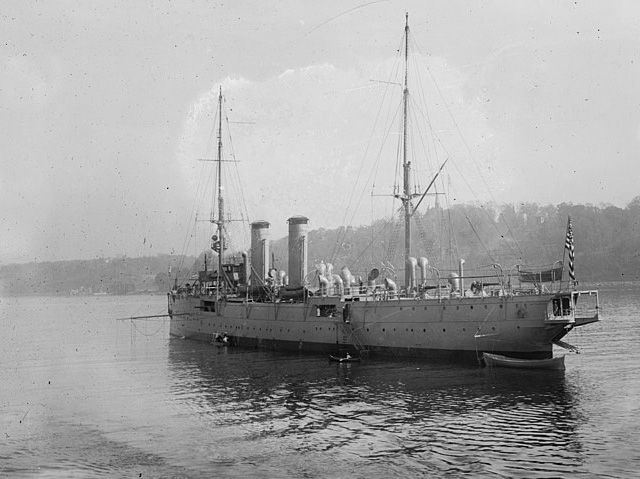
USS San Francisco (C-5) was a follow-up of this design, but modernized. She was built to Navy Department plans with twelve 6 inch (152 mm)/30 caliber guns, with pairs at the bow and stern, remainder in sponsons amidships, quite a classic recipe but the guns were faster and longer range.
She was ordered on 3 March 1887 and Awarded on 26 October 1887 to Union Iron Works in San Francisco (California).
She was laid down on 14 August 1888, launched on 26 October 1889, sponsored by Miss Edith W. Benham (wife of future rear admiral Andrew E. K. Benham).
USS San Francisco was commissioned on 15 November 1890 at a cost of $1,428,000 as contracted for the hull and machinery. The Navy had to provide the rest.
USS Philadelphia’s Design
Hull and general design
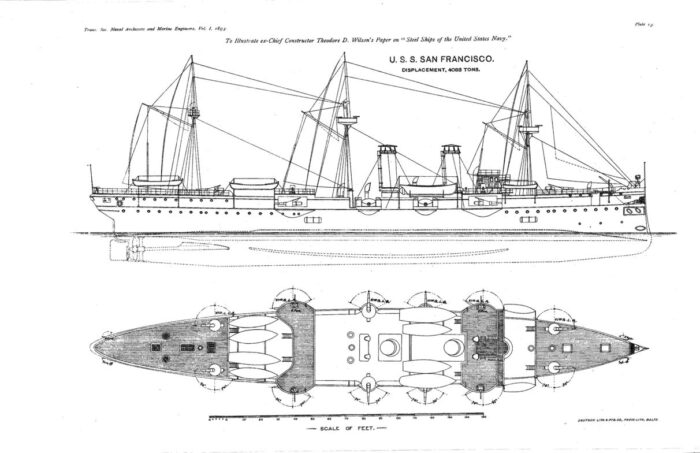
Original plans-like rendition, from Robert Jensen via navsource src.
USS San Francisco displaced 4,088 long tons (4,154 t) standard and 4,583 long tons (4,657 t) full load. She measured 324 ft 6 in (98.91 m) overall but 310 ft (94 m) between parallels. For her beam she was 49 ft 2 in (14.99 m) wide, and her draft varied between the froward and aft and mean and max values of 18 ft 9 in (5.72 m) (mean) and 22 ft 4 in (6.81 m) (max). She was thus almost the same displacement, slightly shorter, slightly wider, less draftier.
Like Newark she combined features such as a ram and a clipper style poop, protruding largely over the squared rudder. Her rounded hull had a slanted keel fore and aft. Her sides were completely flat, without tumbelhome, she had a high freeboard, for three stages of portholes forward (electric lighting in her lower hull), but her rigging was far less developed than Newark. Instead of a barque, she had a simplified, smaller and lighter schooner rig, with large fighting tops supporting both 1-pdrs and Gatling MGs. As customary at the time she had white hull and decorated prow.
Her deck supported the four sponsons main guns amidships, and she had a short forecastle followed by a fully decked transverse “bridge” roof over the first sponsoned guns, same arrangement aft. Two raked funnels (as the masts) and a long aft deck. She had three anchors and four coal hatches in the lower hull as well as three light projectors, eight boats under davits and six on deck for a crew of 384, 34 officers and 350 enlisted men. Her small bridge sat on top of the conning tower, with precious wooden paneling, and with an open bridge atop.
USS San Francisco’s Powerplant
As-built the San Francisco kept the same engineering plant as Newark with two horizontal triple expansion engines fed in turn by four coal-fired double-ended cylindrical boilers working at 135 psi (930 kPa). This powerplant, dirving two shafts for two 4-bladed propellers, totalled 10,500 ihp (7,800 kW) as designed. This was intended to procure a top speed of 19 knots (35 km/h; 22 mph), reached on trials but on an output below contract at 9,912 ihp (7,391 kW). USS San Francisco was the also very last US Navy cruiser fitted with sails, albeit this was a limited schonner rig, which needed still a good portion of the crew to man these. This was soon removed.
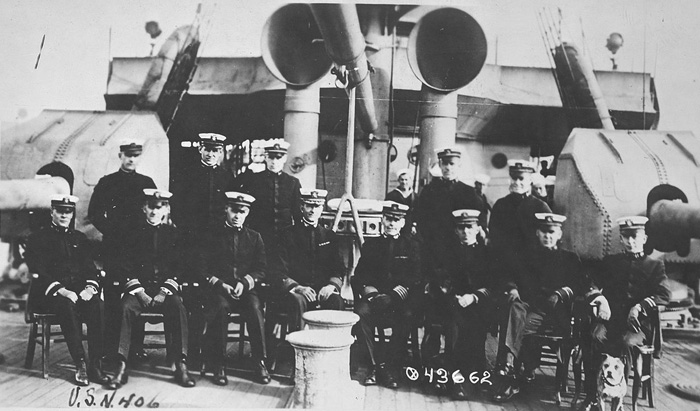
She carried 350 tons of coal and her designed range on steam along was 3,432 nmi (6,356 km; 3,949 mi) at 10 knots (19 km/h; 12 mph) and in wartime, by filling supplementary compartments this can reach up to 850 tons for 8,333 nmi (15,433 km; 9,589 mi) if necessary.
The powerplant was completely rebuilt ler in her career. In between VTE (vertical, small tubes) became the norm.
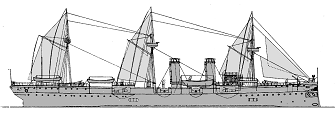
USS San Francisco’s original schooner rig (from navypedia) as a development of the plan above.
Protection
USS San Francisco was protected in a very same way as the previous Newark, lightly to say the least, she was a protected cruiser still. The main guns were all protected by 2 inches (51 mm) sloped but flat gun shields. She had a 3 inches (76 mm) conning tower. The armored deck which replaced a belt was shaped the same way as European standards, with a central flat section which was up to 3 inches (76 mm) thick whereas the centre flat section was 2 in (51 mm) thick. ASW compartimentation existed, but nothing that could resist to a torpedo blast of WWI standards.
Armament
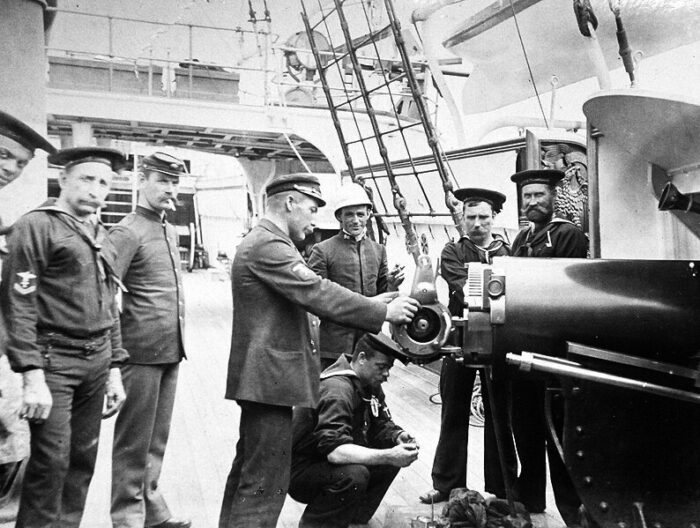
The ordnance officer showing the proper cleaning of a 6-in gun barrel
USS San Francisco based on Navy Department plans featured the same twelve 6 inch (152 mm)/30 caliber guns, albeit of a new model, the Mark 3. In addition, unlike Newark the guns were a deck higher, not in sponsons. This was due to the need of better arcs of fire and progresses made in stability. Two were thus located as pairs at the bow and stern (forecastle and poop deck), the remainder located lower on the open battery deck in sponsons along the sides, four covering forward and aft and four with more limited angles covering the broadsides.
The Secondary armament comprised four 6-pounder (57 mm (2.2 in)) guns and four 3-pounder (47 mm (1.85 in)) Hotchkiss revolving cannons. This was rounded plus two 1-pounder (37 mm (1.5 in)) Hotchkiss revolving cannon and two .45 caliber (11.4 mm) Gatling guns in the fighting tops. Each Hocthkiss pointed forward, the Gatling faced aft of these tops. Here are tech details.
6-inch/30-caliber gun Mark 3

Staged photo showing gunner “Frenchy” and his 6-in breech and shield. Detroit city coll.
Same model as other US cruisers from the ABCD and onwards but of the model Mark 3 (ISS Dolphin had Mark 1, The Atlanta class Mark 2). They were shared by USS Maine, Texas, Newark, Charleston and Baltimore among others. Central-pivot 196 in (5,000 mm) long, c10,000 lb (4,700 kg).
In short: −10° to +12° elevation, 0.66 rpm, 105 lb (48 kg) naval armor-piercing shell, 1,950 ft/s (590 m/s), range 9,000 yd (8,200 m) at 15.3° elevation.
6-pounder (57 mm/40 (2.2 in)) Hotchkiss Mk I/II
They were located on top of the casemated fore and aft sponson battery deck guns. They fired a 57x307R, 25 rpm, mv 1,818 feet per second (554 m/s) max range 4,000 yards (3,700 m)
3-pounder (47 mm/40 (1.85 in)) Hotchkiss Mk I/Driggs-Schroeder Mk I
Four, location unclear. Fixed QF 47×376 mm R 3 kg (6.6 lb), 30 rpm mv 571 m/s (1,870 ft/s) range 5.9 km (3.7 mi) at +20°.
1 pdr Hotchkiss Mark I
Two 1-pounder (37 mm/20 (1.5 in)) Hotchkiss revolving cannon located in the fighting tops alongside the two .45 caliber (11.4 mm) Gatling guns.
Similar to the British water-jacketed guns, rapid fire. The gun was originally a scaled up Maxim machine gun (Maxim-Nordenfelt 37 mm). It was belt fed, up to 300 rpm cyclic. mv 1,800 ft/s (550 m/s and max range 4,500 yards (4,110 m).
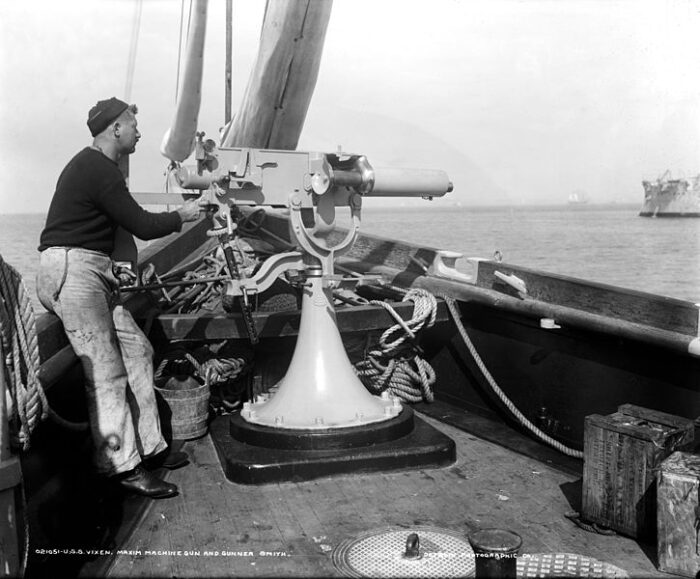
Maxim-Nordenfelt HMG on USS Vixen
Upgrades
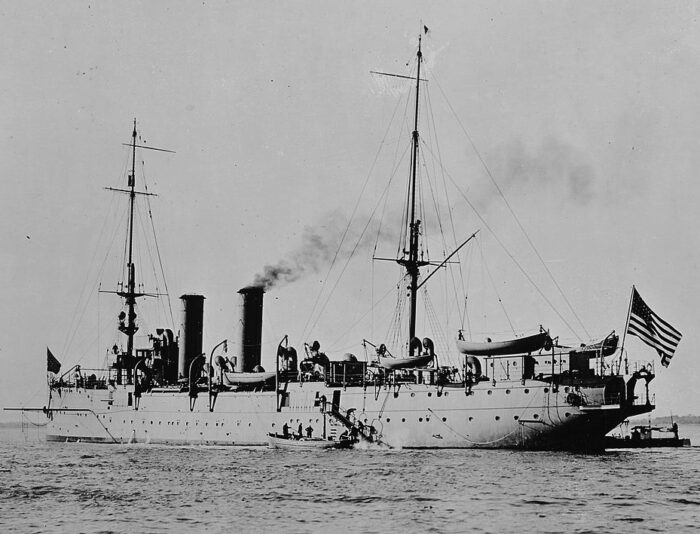
San Francisco in 1916 as a minelayer
In 1902 all her 30 caliber guns were replaced by faster, long range 6-inches 41 caliber Mk IV.
From 1908 to 1911 in Norfolk N Yd at Portsmouth she was rebuilt as a minelayer. Her powerplant was modernized to eight Babcock & Wilcox boilers for a total of 9,761 shp (7,279 kW) (ihp on trials). Speed unknown, perhaps 20 knots or more.
Her Armament was also completely modified. She was left with eight 5-inches (127mm)/40 Mk III guns and a stowage for 180 Mark II mines.
She also had a new close quarter defensive artillery of four 6-pounder 57 mm (2.2 in) guns.
In 1918 her 5-in/40 were all replaced by four 5-in/51 Mk VIII. She kept her light guns and mines.
The Mark II mines were designed by Sauter-Harle (FR) as spherical models with a 175 lbs. (79 kg) charge of wet guncotton. They used a contact-inertial exploder, entering service about 1909. ref

Old author’s illustration
⚙ specifications |
|
| Displacement | 4,088 long tons (4,154 t) standard, 4,583 long tons (4,657 t) full load |
| Dimensions | 324 ft 6 in x 49 ft 2 in x 22 ft 4 in (98.91 x 14.99 x 6.81 m) |
| Propulsion | 2× HTE steam engines, 4× steam boilers, 10,500 ihp (7,800 kW) |
| Speed | 19 knots (35 km/h; 22 mph) |
| Range | 3,432 nmi (6,356 km; 3,949 mi) at 10 kn (19 km/h; 12 mph) |
| Armament | 12× 6-in/30 RML, 4×6-pdr, 4×3-pdr, 2×1-pdr, 4× 0.45 in Gatling guns |
| Protection | Gun shields 2 in, Main deck 2-3 in, CT 3 in |
| Crew | 30 officers and 350 enlisted |
Career of USS San Francisco

As completed, USS San Francisco was assigned to the South Pacific Squadron as flagship on 31 March 1891. In the summer, she was vigilant in waters close to Chile to protect US interests during the 8-month-old civil war. She landed a party with Marines to protect the Consulate. The war ended in September and she resumed her cruising off the South American coast. In 1892 she sailed for Hawaii, stopped at Honolulu on 27 February as an other civil war loomes there between monarchists and republicans. She departed Hawaii in August 1892 for Norfolk and arrived on February 1893.
She was now flagship of the North Atlantic Squadron from 31 May. She started exercises along the New England coast and in November, sailed to the Caribbean. By late December she stopped at Rio de Janeiro and was agains flagship, South Atlantic Squadron. She visited more ports in Brazil, but also the Netherlands West Indies as well as Colombia, Costa Rica, and Nicaragua over six months and back home to New York City on 29 July 1894.

In 1895 she continued her deployment training, and in January, crossed the Atlantic for the eastern Mediterranean Sea due to growing tension within the Ottoman Empire. She remained in European waters as flagship for Commodore Thomas O. Selfridge Jr. (European Squadron) until 1896. In March she sailed back home, and was manoeuvering on the east coast when war flared out with Spain in April 1898. She started patrol duties along the Florida coast, and pushed off Cuba. In July, Spain peace negociation commenced and in August, USS san Francisco was back to Hampton Roads and then decommissioned at Norfolk on 25 October.
She was recommissioned on 2 January 1902, received an overhaul and gun upgrade, and returned to the European Squadron. In September she was back in home waters and in the Caribbean. She returned to the Mediterranean in 1903 and then visited Asiatic squaron until the fall of 1904. She entered Norfolk Navy Yard for a short refit and was placed in decommissioned reserve on 31 December.
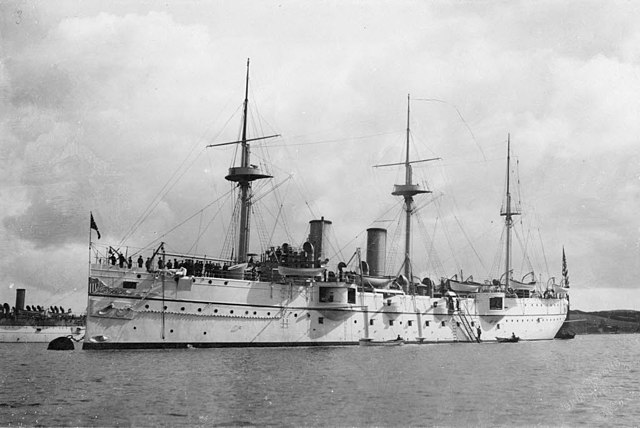
San Francisco prewar in Kiel
In June 1908, the USN decided she was worthless as a cruise and instead wanted her refitted as a minelaying, which lacked in the US inventory and were considered a valuable asset in case of a new war in Europe. In 1910, she was rearmed with new guns and received facilities to carry and lay some 300 Mark II mines. On 21 August 1911, she was recommissioned but maintained in reserve to be deployed in wartime. She received a crew just to participate in the Fleet Review at New York and eventualy she was fully commissioned on 29 November at least to start training as a minelayer.
She beame a “mine planter” on 19 December 1912, based in Norfolk, operating off in the western Atlantic and Caribbean. In 1914 she took part in the occupation of Veracruz. In 1916 she was inactivated again, as training was complete. She was placed in reserve at Portsmouth on 6 June, but resumed full commission on 18 October. When the US entered the war in April 1917 her first role was to lay anti-submarine nets at Hampton Roads. In June she was based in New York, to test new experimental deep water minelaying operations.
In August, she was overhauled accordingly at Portsmouth Navy Yard, completed by mid-September, as she returned to New London and continue her duties as net laying ship. She was reassigned to Norfolk for training and from December 1917 to March 1918, she had yet another, extensive overhaul while becoming flagship of the young US Navy Mine Squadron 1.
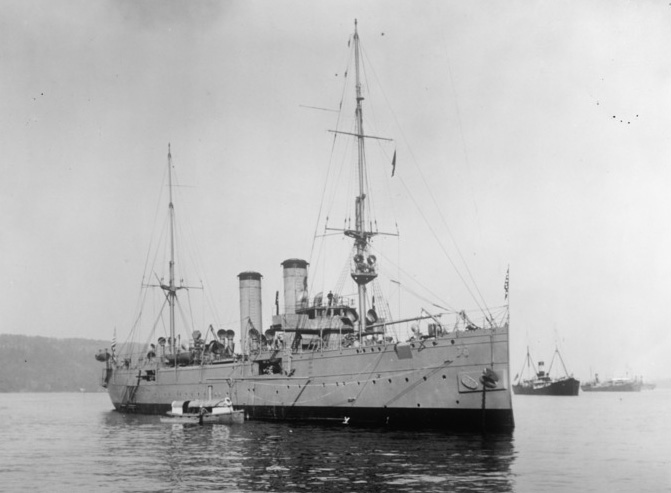
San Francisco in 1916-17 as a minelayer
In early May, the squadron was completed at Newport in Rhode Island and sailed on 12 May for England. On the 26th they were escorted by the Royal Navy into Inverness as their next operating base. USS San Francisco thus joined the Allied North Sea Mine Barrage, across the North Sea in order to prevent passage of German U-boat into the Atlantic. In 13 missions she laid a total of 9,102 mines between June and October 1918.
On 12 August this was for field test sensitivity settings for the antenna fuze of the detonating relay of the new Mk 6 mines.
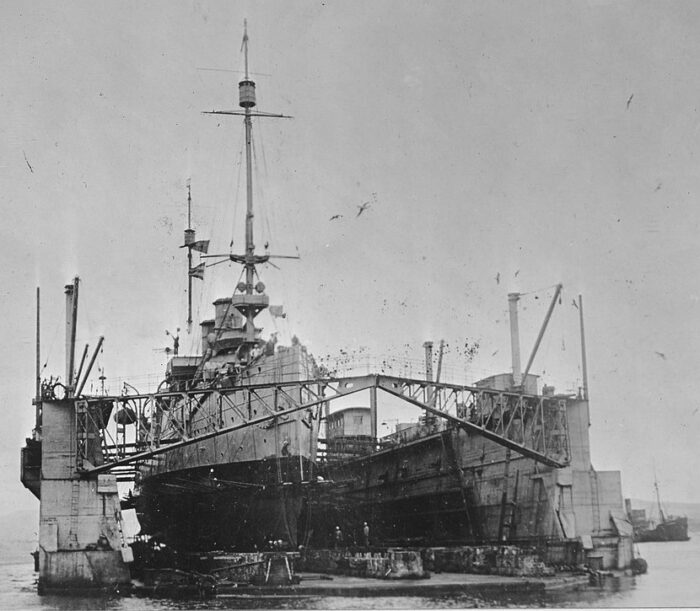
In drydock at Invergordon, 1918
As the Armistice came on 11 November she was prepared to return home, departing Inverness on 2 December, arriving in Hampton Roads on 3 January 1919. She had another overhaul and rearmament, before resuming training cruisers on the western Atlantic and Caribbean until 1921. Her designation was changed for CM-2 (cruiser minelayer) on 17 July 1920 but she was inactivated in 1921. On 6 October 1921 she proceeded to Philadelphia to be decommissioned on 24 December.
Her name being needed for more modern ships she was renamed USS Tahoe, and then USS Yosemite for CA-38 from 1 January 1931. She then remained at Philadelphia for eight more years until stricken, still in reserve, Naval Vessel Register on 8 June 1937, retained as accomodation ship for the Navy Yard until sold to Union Shipbuilding Co. of Baltimore on 20 April 1939 and scrapped as WW2 flared out, for her much needed steel.
Read More/Src

Staff of the cruiser in 1921
Books
US Navy Department. 1 January 1914. pp. 138–141.
Toppan, Andrew (8 September 1996). “US Cruisers List: Protected Cruisers and Peace Cruisers”. Hazegray.org.
“Ships’ Data, U.S. Naval Vessels”. US Navy Department. 1 July 1921. p. 72.
Bauer, K. Jack; Roberts, Stephen S. (1991). Register of Ships of the U.S. Navy, 1775–1990. Greenwood Press.
Belknap, Reginald Rowan. The Yankee Mining Squadron; or, Laying the North Sea Mining Barrage (1920) NIP
Burr, Lawrence. US Cruisers 1883–1904: The Birth of the Steel Navy. Oxford : Osprey, 2008.
Friedman, Norman (1984). U.S. Cruisers: An Illustrated Design History. NIP
Gardiner, Robert; Chesneau, Roger (1979). Conway’s All the World’s Fighting Ships 1860–1905.
Jane’s Fighting Ships of World War I. London: Random House Group, Ltd. 2001.
Warship International Staff (2015). “International Fleet Review at the Opening of the Kiel Canal, 20 June 1895”.
Links
on history.navy.mil/ san-francisco-i.html
on navypedia.org/
on worldnavalships.com
on hazegray.org/
on commons.wikimedia.org/
on en.wikipedia.org/
on navsource.org
3D, scale models
on bob.plord.net/ SpanishAmerican SanFrancisco tabletop model
C-5 San Francisco Oceanmoon | No. WM03528 | 1:700

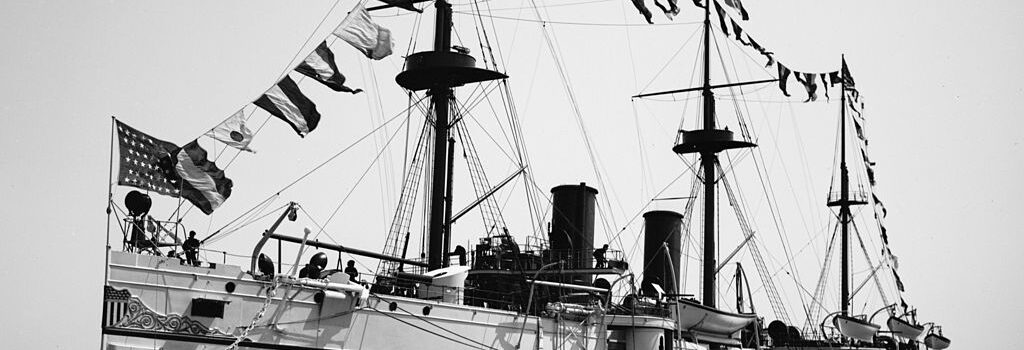
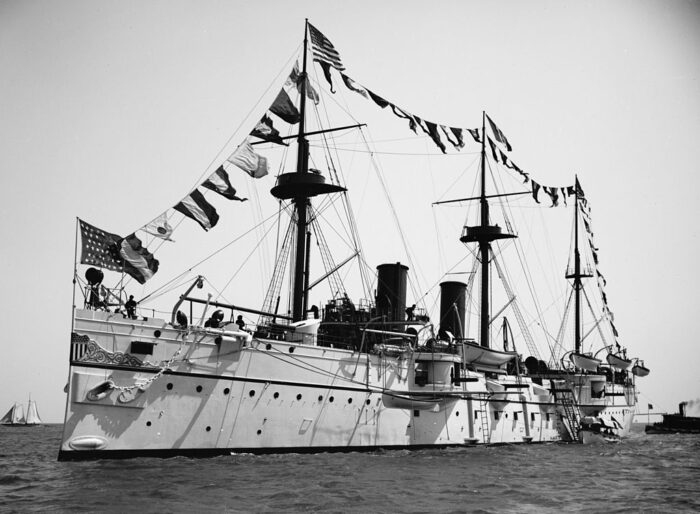
 Latest Facebook Entry -
Latest Facebook Entry -  X(Tweeter) Naval Encyclopedia's deck archive
X(Tweeter) Naval Encyclopedia's deck archive Instagram (@navalencyc)
Instagram (@navalencyc)





 French Navy
French Navy Royal Navy
Royal Navy Russian Navy
Russian Navy Armada Espanola
Armada Espanola Austrian Navy
Austrian Navy K.u.K. Kriegsmarine
K.u.K. Kriegsmarine Dansk Marine
Dansk Marine Nautiko Hellenon
Nautiko Hellenon Koninklije Marine 1870
Koninklije Marine 1870 Marinha do Brasil
Marinha do Brasil Osmanlı Donanması
Osmanlı Donanması Marina Do Peru
Marina Do Peru Marinha do Portugal
Marinha do Portugal Regia Marina 1870
Regia Marina 1870 Nihhon Kaigun 1870
Nihhon Kaigun 1870 Preußische Marine 1870
Preußische Marine 1870 Russkiy Flot 1870
Russkiy Flot 1870 Svenska marinen
Svenska marinen Søværnet
Søværnet Union Navy
Union Navy Confederate Navy
Confederate Navy Armada de Argentina
Armada de Argentina Imperial Chinese Navy
Imperial Chinese Navy Marinha do Portugal
Marinha do Portugal Mexico
Mexico Kaiserliche Marine
Kaiserliche Marine 1898 US Navy
1898 US Navy Sovietskiy Flot
Sovietskiy Flot Royal Canadian Navy
Royal Canadian Navy Royal Australian Navy
Royal Australian Navy RNZN Fleet
RNZN Fleet Chinese Navy 1937
Chinese Navy 1937 Kriegsmarine
Kriegsmarine Chilean Navy
Chilean Navy Danish Navy
Danish Navy Finnish Navy
Finnish Navy Hellenic Navy
Hellenic Navy Polish Navy
Polish Navy Romanian Navy
Romanian Navy Turkish Navy
Turkish Navy Royal Yugoslav Navy
Royal Yugoslav Navy Royal Thai Navy
Royal Thai Navy Minor Navies
Minor Navies Albania
Albania Austria
Austria Belgium
Belgium Columbia
Columbia Costa Rica
Costa Rica Cuba
Cuba Czechoslovakia
Czechoslovakia Dominican Republic
Dominican Republic Haiti
Haiti Hungary
Hungary Honduras
Honduras Estonia
Estonia Iceland
Iceland Eire
Eire Equador
Equador Iran
Iran Iraq
Iraq Latvia
Latvia Liberia
Liberia Lithuania
Lithuania Mandchukuo
Mandchukuo Morocco
Morocco Nicaragua
Nicaragua Persia
Persia San Salvador
San Salvador Sarawak
Sarawak Uruguay
Uruguay Venezuela
Venezuela Zanzibar
Zanzibar Warsaw Pact Navies
Warsaw Pact Navies Bulgaria
Bulgaria Hungary
Hungary

 Bundesmarine
Bundesmarine Dutch Navy
Dutch Navy Hellenic Navy
Hellenic Navy Marina Militare
Marina Militare Yugoslav Navy
Yugoslav Navy Chinese Navy
Chinese Navy Indian Navy
Indian Navy Indonesian Navy
Indonesian Navy JMSDF
JMSDF North Korean Navy
North Korean Navy Pakistani Navy
Pakistani Navy Philippines Navy
Philippines Navy ROKN
ROKN Rep. of Singapore Navy
Rep. of Singapore Navy Taiwanese Navy
Taiwanese Navy IDF Navy
IDF Navy Saudi Navy
Saudi Navy Royal New Zealand Navy
Royal New Zealand Navy Egyptian Navy
Egyptian Navy South African Navy
South African Navy






























 Ukrainian Navy
Ukrainian Navy dbodesign
dbodesign